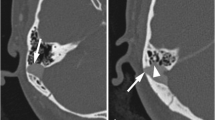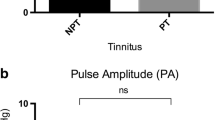Abstract
Purpose
This aimed to evaluate the prevalence and extent of bilateral sigmoid sinus dehiscence (SSD) and to explore the presence of idiopathic intracranial hypertension (IIH) in patients with unilateral pulsatile tinnitus (PT) with CTA/V.
Methods
Sixty PT patients (52 females; 40.4 ± 11.6 years [20–72]) who underwent CTA/V and 30 non-PT patients (27 females; 38.4 ± 14.7 years [12–62]) were enrolled in this study. The primary outcome measure was the radiographic presence of SSD. The index of transverse sinus stenosis (ITSS) was obtained by multiplying the stenosis scale values for each transverse sinus, and once was ≥ 4, the presence of IIH was suspected.
Results
The prevalence and extent of SSD on symptomatic side (78%; maximum transverse diameter, MTD 0.49 ± 0.23; maximum vertical diameter, MVD 0.50 ± 0.26 cm) were significantly higher and larger than those on asymptomatic side (50%, P < 0.001; MTD 0.35 ± 0.18, P = 0.006; MVD 0.30 ± 0.15 cm, P < 0.001) in the study group and those (20%, P < 0.001; MTD 0.36 ± 0.18, P = 0.073; MVD 0.30 ± 0.22 cm, P < 0.048) in the control group. The presence of SSD showed significant correlation with both PT (logistic regression analysis, OR 4.167 [1.450–11.97]; P = 0.008) and suspected IIH (OR 16.25 [1.893–139.5]; P = 0.011).
Conclusion
In PT patients, SSD has a significant correlation with PT and a potential correlation with IIH.



Similar content being viewed by others
References
Mundada P, Singh A, Lingam RK (2015) CT arteriography and venography in the evaluation of pulsatile tinnitus with normal otoscopic examination. Laryngoscope 125(4):979–984
Schoeff S, Nicholas B, Mukherjee S et al (2014) Imaging prevalence of sigmoid sinus dehiscence among patients with and without pulsatile tinnitus. Otolaryngol Head Neck Surg 150:841–846
Eisenman DJ (2011) Sinus wall reconstruction for sigmoid sinus diverticulum and dehiscence: a standardized surgical procedure for a range of radiographic findings. Otol Neurotol 32(7):1116–1119. https://doi.org/10.1097/MAO.0b013e31822a1c7d
Wang GP, Zeng R, Liu ZH et al (2014) Clinical characteristics of pulsatile tinnitus caused by sigmoid sinus diverticulum and wall dehiscence: a study of 54 patients. Acta Otolaryngol 134(1):7–13
Liu Z, Dong C, Wang X et al (2015) Association between idiopathic intracranial hypertension and sigmoid sinus dehiscence/diverticulum with pulsatile tinnitus: a retrospective imaging study. Neuroradiology 57(7):747–753
Shaw GY, Million SK (2012) Benign intracranial hypertension: a diagnostic dilemma. Case Rep Otolaryngol 2012:814696
Grewal AK, Kim HY, Comstock RH et al (2014) Clinical presentation and imaging findings in patients with pulsatile tinnitus and sigmoid sinus diverticulum/dehiscence. Otol Neurotol 35(1):16–21. https://doi.org/10.1097/MAO.0b013e31829ab6d7
Horev A, Hallevy H, Plakht Y et al (2013) Changes in cerebral venous sinuses diameter after lumbar puncture in idiopathic intracranial hypertension: a prospective MRI study. J Neuroimaging 23(3):375–378
Riggeal BD, Bruce BB, Saindane AM, Ridha MA, Kelly LP, Newman NJ, Biousse V (2013) Clinical course of idiopathic intracranial hypertension with transverse sinus stenosis. Neurology 80(3):289–295. https://doi.org/10.1212/WNL.0b013e31827debd6
Saindane AM, Bruce BB, Riggeal BD, Newman NJ, Biousse V (2013) Association of MRI findings and visual outcome in idiopathic intracranial hypertension. Am J Roentgenol 201(2):412–418. https://doi.org/10.2214/AJR.12.9638
Farb RI, Vanek I, Scott JN et al (2003) Idiopathic intracranial hypertension: the prevalence and morphology of sinovenous stenosis. Neurology 60:1418–1424
Maralani PJ, Hassanlou M, Torres C et al (2012) Accuracy of brain imaging in the diagnosis of idiopathic intracranial hypertension. Clin Radiol 67(7):656–663
Morris PP, Black XD, Port XJ et al (2017) Transverse sinus stenosis is the most sensitive MR imaging correlate of idiopathic intracranial hypertension. AJNR Am J Neuroradiol 38(3):471–477. https://doi.org/10.3174/ajnr.A5055
Carvalho GB da S, Matas SL de A, Idagawa MH et al (2016) A new index for the assessment of transverse sinus stenosis for diagnosing idiopathic intracranial hypertension. J Neuro Intervent Surg 9(2):173–177
Dong C, Zhao P, Liu Z et al (2016) Association between the extent of sigmoid sinus dehiscence and an occurrence of pulsatile tinnitus: a retrospective imaging study. Clin Radiol 71:883–888
Liu Z, Chen C, Wang Z et al (2013) Sigmoid sinus diverticulum and pulsatile tinnitus: analysis of CT scans from 15 cases. Acta Radiol 54(7):812–816
Hou ZQ, Han DY (2011) Pulsatile tinnitus in perimenopausal period. Acta Otolaryngol 131(8):896–904. https://doi.org/10.3109/00016489.2011.567998
Otto KJ, Hudgins PA, Abdelkafy W, Mattox DE (2007) Sigmoid sinus diverticulum: a new surgical approach to the correction of pulsatile tinnitus. Otol Neurotol 28(1):48–53. https://doi.org/10.1097/01.mao.0000247814.85829.f6
Sismanis A (2011) Pulsatile tinnitus: contemporary assessment and management. Curr Opin Otolaryngol Head Neck Surg 19(5):348–357. https://doi.org/10.1097/MOO.0b013e3283493fd8
Wall M, George D (1991) Idiopathic intracranial hypertension. A prospective study of 50 patients. Brain 114(Pt 1A):155–180
Lansley JA, Tucker XW, Eriksen XM et al (2017) Sigmoid sinus diverticulum, dehiscence, and venous sinus stenosis: potential causes of pulsatile tinnitus in patients with idiopathic intracranial hypertension? AJNR Am J Neuroradiol 38(9):1783–1788. https://doi.org/10.3174/ajnr.A5277
Harvey RS, Hertzano R, Kelman SE et al (2014) Pulse-synchronous tinnitus and sigmoid sinus wall anomalies: descriptive epidemiology and the idiopathic intracranial hypertension patient population. Otol Neurotol 35:7–15
Friedman DI, Liu GT, Digre KB (2013) Revised diagnostic criteria for the pseudotumor cerebri syndrome in adults and children. Neurology 81(13):1159–1165. https://doi.org/10.1212/WNL.0b013e3182a55f17
Author information
Authors and Affiliations
Corresponding author
Ethics declarations
Funding
No funding was received for this study.
Conflict of interest
The authors declare that they have no conflict of interest.
Ethical approval
All procedures performed in the studies involving human participants were in accordance with the ethical standards of the institutional and/or national research committee and with the 1964 Helsinki Declaration and its later amendments or comparable ethical standards.
Informed consent
For this type of retrospective study formal consent is not required.
Rights and permissions
About this article
Cite this article
Xu, S., Ruan, S., Liu, S. et al. CTA/V detection of bilateral sigmoid sinus dehiscence and suspected idiopathic intracranial hypertension in unilateral pulsatile tinnitus. Neuroradiology 60, 365–372 (2018). https://doi.org/10.1007/s00234-018-1987-3
Received:
Accepted:
Published:
Issue Date:
DOI: https://doi.org/10.1007/s00234-018-1987-3




